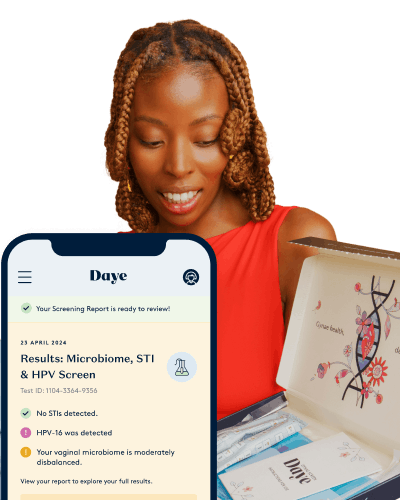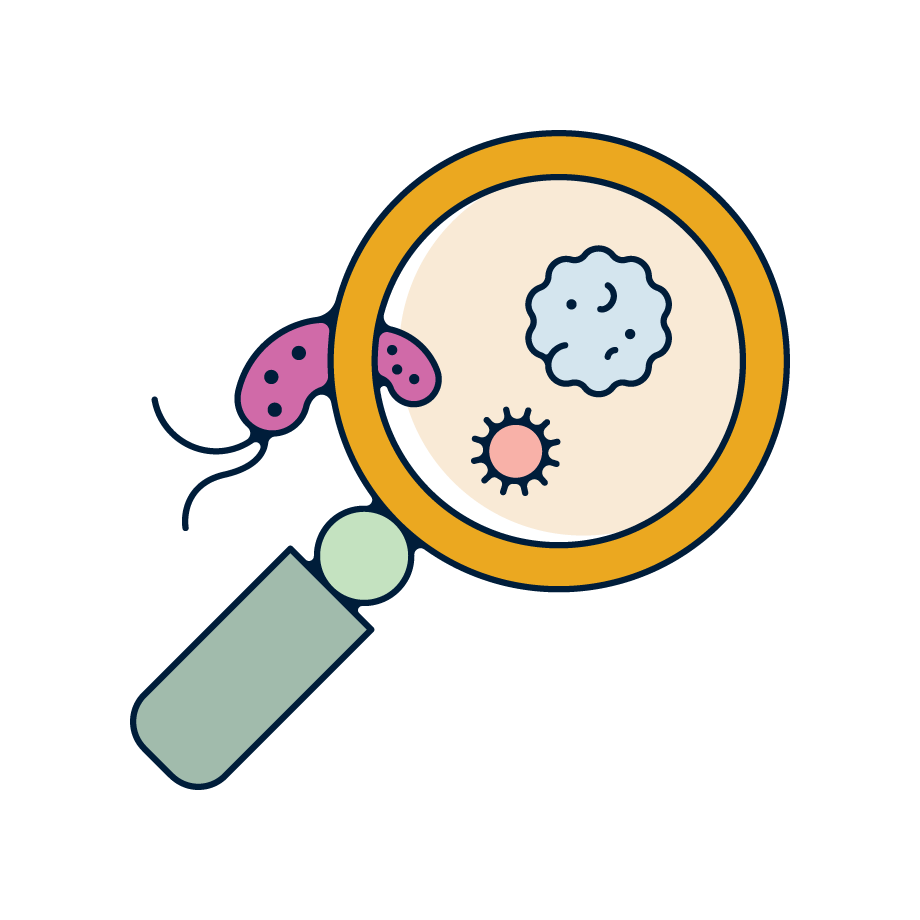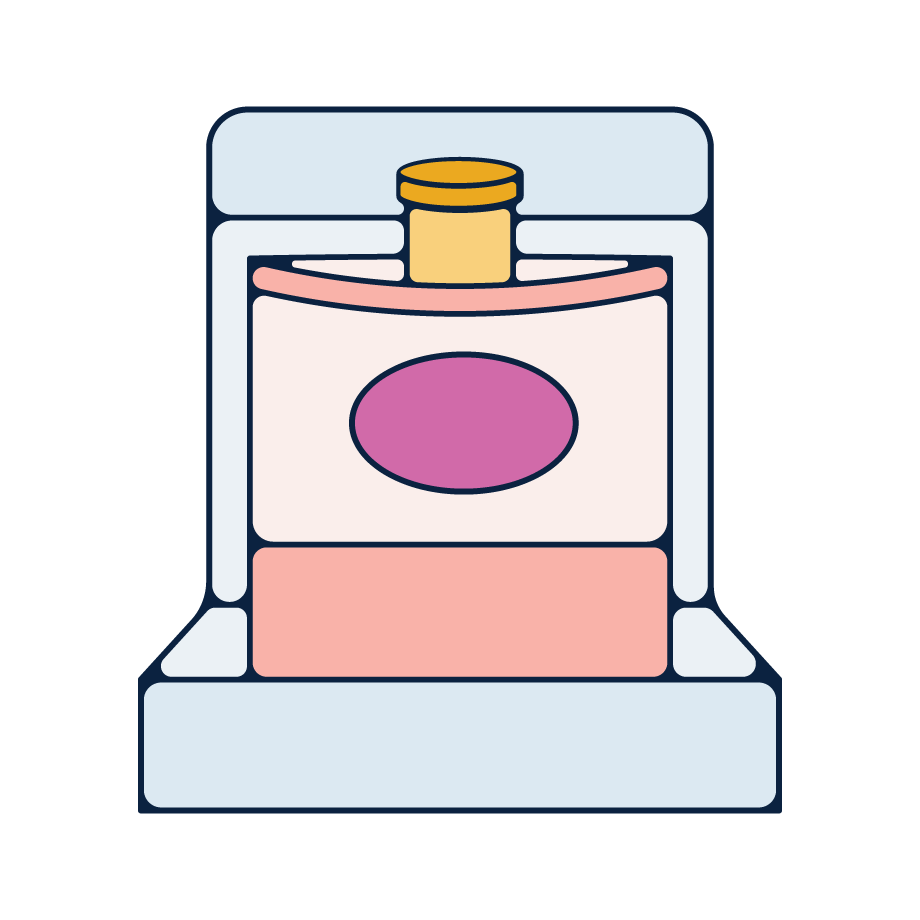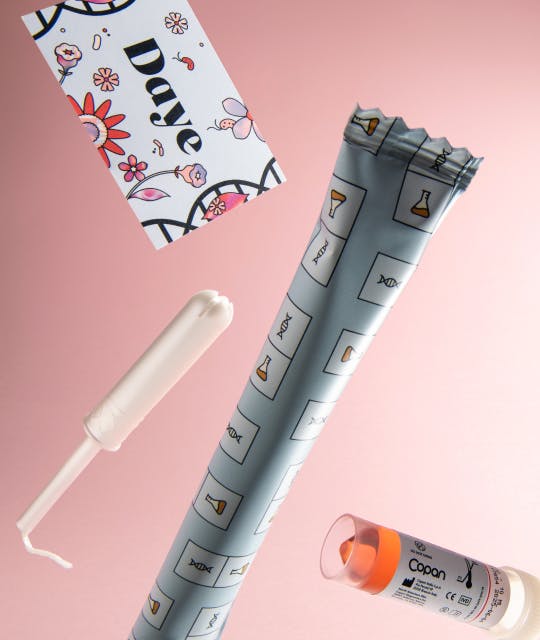Table of contents
1. What exactly is chlamydia?
2. How do chlamydia tests work?
3. How can I test for chlamydia at-home?
4. Are home STI test kits accurate?
5. How often should I test for chlamydia and other STIs?
Medically reviewed by Sarah Montagu (NPs, SRH). Sarah is a highly qualified sexual and reproductive health nurse with 15+ years of experience.
Illustrated by Sabrina Bezerra, Erin Rommel & Maria Papazova
Worried about STIs?
As many as 70% of female STIs are asymptomatic, making proactive screening essential.

In between meetings, you’ve dashed to the loo at work. You hurriedly sit down in the dimly lit cubicle, expecting to be away from your desk for no more than three minutes – but then, you notice a distinctly painful sensation as you pee. You frown; but no, you’re definitely not imagining it. It burns, and it’s sore.
Or, maybe, you notice some bizarrely unusual discharge in your underwear as you hike them down; or perhaps, you bring the loo roll away to find spots of blood – and it most definitely isn’t anywhere close to your period.
If you’re noticing any of these symptoms – painful urination, a change to your vaginal discharge or bleeding between periods or after sex, there's a possibility you might have chlamydia.
Yes, ok, we said the word that strikes fear into hearts (and wombs) – but don't panic. Seriously; slow your breathing down and let that panic ebb away. Chlamydia is one of the most common sexually transmitted infections (STIs) and it's completely curable. All you'll probably need to do is take a round of antibiotics and you'll be all clear. Plus, if you catch your chlamydia infection early, it’s unlikely to have any long-term health consequences.
Breathing easier now? Good.
And, while the symptoms of chlamydia can certainly be unpleasant and embarrassing, just remember – these are a helpful sign that something's wrong. You could almost (almost) go as far as saying we should welcome any symptoms, because chlamydia is often asymptomatic: studies show that as many as 70% of Chlamydia cases can be asymptomatic.
If you start seeing symptoms, you're actually one of the lucky ones; this means you can get treatment and cure the STI quickly and easily. Untreated chlamydia can lead to long-term fertility challenges or chronic pelvic pain, so it’s vital to pay attention to these all-important symptoms, as well as to get tested regularly and proactively.
The latter is easier said than done, though, right? Finding the time to get to a sexual health clinic can be tricky – plus, while we certainly advocate booking an appointment, we also understand why this might give people anxiety. Happy news, though: whether you're worried about symptoms or want to get checked out just in case, at-home chlamydia test kits are available and provide highly accurate results (especially when the sample is collected with a tampon, which allows for greater bacterial mass to be sent to the lab).
We'll explain where to get them and how to use the test kit later on. First, though, let's take a closer look at this common STI and how testing works. Knowledge is power.
What exactly is chlamydia?

With almost 200,000 diagnoses in 2022, it seems almost trite to state that chlamydia is a common STI in the UK; but common, it certainly is. It's spread through:
- Unprotected oral, vaginal and anal sex
- Sharing sex toys
- Passing from a pregnant mother to her child
- Getting infected vaginal fluid or semen in your eye
Chlamydia screening is key – it’s vital to treat the infection as soon as possible to avoid spreading it to other sexual partners. If left untreated, there's also a risk that it can spread in the body and cause complications like pelvic inflammatory disease or ectopic pregnancy.
Again, though: don’t panic – chlamydia treatment options are both quick and easy. You'll be prescribed a short course of antibiotics such as doxycycline or azithromycin.
Despite their intimidating names, they’ll do the job – but antibiotics are likely to disrupt your gut and vaginal microbiome, so you should take extra care to repopulate your good bacteria after an antibiotics course. You could opt for a course of probiotics, or just increase your intake of probiotic-rich foods like kimchi and kefir. Yum.
How do chlamydia tests work?
There are two main ways of testing for chlamydia in women and AFAB folk: a urine test and a swab.
Urine sample

The urine test involves collecting a sample by peeing in a small container (yep, we all hate it; but it has to be done, folks). Then, a Nucleic Acid Amplification Test (NAAT) is used to detect whether the bacteria that cause chlamydia are present in the sample. If the test finds this bacteria's DNA, you will test positive for chlamydia.
Pros:
- No need for uncomfortable swab samples
- Can be quick and easy
Cons:
- Peeing in a tube can be a challenge if you're not used to it
- Might be uncomfortable if you're already experiencing chlamydia symptoms like painful peeing
- Urine is considered less accurate compared to vaginal samples, especially if these are collected with a tampon. According to a meta-analysis, the pooled sensitivity estimates for vaginal swabs and urine were 94.1% and 86.9%, respectively. Tampons collect more bacterial mass than swabs, which increases the diagnostic accuracy of tests.
Swab sample

These are taken from the vagina, anus, throat, or cervix; and the trusty NAAT, again, is often used to test for the chlamydia-causing bacteria's DNA. Alternatively, your sample might be sent off to a lab to see if the bacteria continue to grow.
Pros:
- Allows for at-home testing
Cons:
- Can be uncomfortable and scary the first time. It can be tricky for some people with limited dexterity. Especially if you haven't done it before.
- It can be easy to contaminate the sample by accidentally touching the perinium
- Some patients report vaginal bleeding after using a swab
- If doing a self swab, it can be hard to know if you've done it right
- They collect less bacterial mass compared to a tampon due to their smaller surface area
- Swabs may miss pathogens that are sneakily hiding in the vaginal canal, whereas tampons collect a sample from the entirety of the vaginal canal and cervix
What about blood tests?

Because it's a bacterial infection, chlamydia is unlikely to show up in a blood test. You'll only need to do a blood test if you're concerned about other STIs like syphilis, HIV, genital herpes, or hepatitis A, B and C.
How can I test for chlamydia at-home?
If you don't want to go to your local sexual health clinic, home STI tests can be a great way to get quick and accurate results. Some services let you order an STI test kit online and get it delivered to your house (in discreet packaging – because, while STIs certainly aren’t anything to be ashamed of, it’s understood why you may not want to broadcast them to the world, either).
Usually, these kits include a vaginal swab for testing for chlamydia. You'll need to insert the swab into your vagina, following the instructions, and then place it in the sealed tube to send back for testing. A few days later, you'll receive a follow-up message with your test results. Simple!
The all-new tampon test kit
We've dropped hint after hint; and now, we’re finally about to bring it into the open. As well as urine samples and swab tests, did you know there's a third, more comfortable option?
Yep – we're (finally) talking about tampon-based STI test kits.
Here at Daye, we’ve developed a (if we say so ourselves) game-changing at-home test kit that lets you test for a variety of STIs like chlamydia and gonorrhoea using an ergonomic, familiar tampon.
If uncomfortable swabs or tricky urine sample tubes don’t float your boat, the tampon test kit uses the familiar form of the tampon for an easier and more relaxed test. With cutting-edge PCR technology for unparalleled sensitivity and accuracy, it collects more vaginal fluid than a standard swab and covers the whole vaginal canal.
This means you get the most comprehensive results possible for all your burning (no pun intended) questions (and the questions you didn’t even know you had), all from the comfort of your home – way less invasive than sticking your legs in stirrups and being cranked open at the gynae’s office.
To do the at-home chlamydia test, you just need to wear the familiar Daye tampon for a short amount of time to collect your sample, then repackage it and send it off to our labs. Your test results will be sent straight to your inbox, alongside personalised treatment advice and next steps if you've (breathe) tested positive for a chlamydia infection.
Pros:
- Comfortable and familiar tampon format takes the fear out of STI testing
- Feel confident with the easy-to-use test kit
- The testing kits also look for gonorrhoea, trichomoniasis, mycoplasma genitalium, mycoplasma hominis, and ureaplasma
Cons:
- Like other at-home test kits, you won't receive your results immediately; so if you're worried about STIs it's best to abstain from unprotected sex until you get your test results. You can expect your results within 5 business days.
Are home STI test kits accurate?
If done correctly, an at-home STI testing kit is just as accurate as the ones you get in your local sexual health clinic – just make sure to carefully follow the instructions. After each screen, patients can book a consultation with a nurse and obtain prescription treatments. If the STI result is positive, then here at Daye we offer a free consultation with an experienced sexual health nurse.
How often should I test for chlamydia and other STIs?

Undetected and untreated chlamydia can lead to serious health problems, so it's important to get tested frequently. For sexually active women and AFAB folks under the age of 25, it's recommended that you get tested once a year.
It's also important to get tested if you have any STI symptoms or have had unprotected sex. We recommend getting an STI test kit every time you start seeing a new sexual partner – far, far better safe than sorry. Remember: many STIs will show no symptoms, so the only way to know if you have one is if you get a positive result after a test. So, on that note: bring on the Daye tampons!
Worried about STIs?
As many as 70% of female STIs are asymptomatic, making proactive screening essential.

Relevant Products







